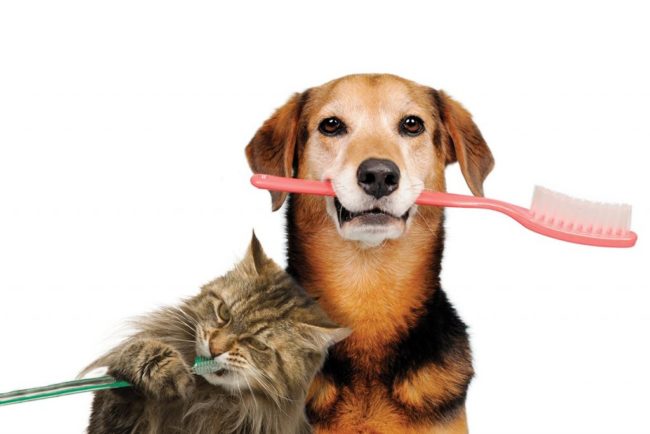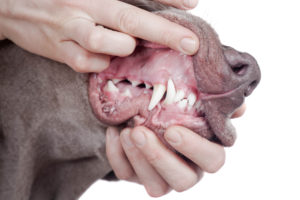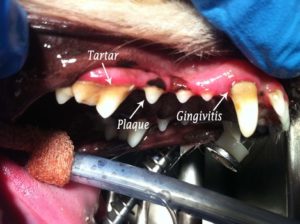According to the American Veterinary Dental Society, 70% of cats and 80% of dogs suffer from some form of dental disease by the time they are 3 years old! Oral hygiene and regular dental care are important factors in maintaining your pet’s overall health and well-being, but this is the one area in which pet owners fail their animals more than any other. Why? Because oral care typically isn’t on our “pet health” radar. Thinking about brushing a cat’s or dog’s teeth can sound silly or impossible, right? Think again! It can be done and it is an important part of your pet’s overall care. We would have a hard time going our whole life without brushing our teeth or having our teeth cleaned. The same can be said about our pets and it is up to us to make this vital change.
What Does a Healthy Mouth Look Like?
Before you learn how to take care of your pet’s teeth (and what will happen if you don’t) you need to understand what a healthy mouth looks like in the first place. A healthy mouth is free of plaque and tartar (hard, scaly or sticky discolorations). The teeth should also be intact and not jagged. Make sure the tongue is moist with no visible lumps or cuts. Your pet’s gums should be pink, not red or swollen.
Pets Are Silent Sufferers: Keep in mind that pets are silent sufferers, and it is rare to notice signs of gum disease unless it is very advanced. However, look out for these signs that your pet may be experiencing oral disease or a condition that needs to be seen and treated by your veterinarian immediately: Drooling, reluctance to eat, dropping food, blood in water bowl or on chew toys, making noises while eating, bad or foul-smelling breath or turning the head to the side when eating.
If Not Treated:
The ultimate goal is to clean your pet’s teeth daily (and if you can’t do it daily, at least 3 times a week) before plaque hardens into tartar. Gingivitis, a form of gum disease, is usually reversible with treatment (cleaning at home and by your vet), but if not addressed, it can progress into the more serious periodontitis (gums pulling away from teeth, bone and tooth loss), which can cause significant pain and affect your dog or cat’s overall health and well-being. Bacteria from the infection can enter the pet’s bloodstream and spread throughout the body, causing damage to the heart, liver and kidneys.
Dr. Lynn Wilson, a Volusia County based veterinarian with over 20 years of experience, has seen this firsthand. She states, “Further damage to your pet’s organs from poor oral health care is not uncommon. In fact, it can shorten your pet’s life.” A good oral home routine for your pet could help to avoid many costly vet visits which might require dental x-rays and anesthesia. On average, a dental cleaning with anesthesia costs anywhere from $400 to $900. As Dr. Wilson points out, “avoiding these issues is all about preventative care and setting up a home routine. If you have a good home care plan, you may never need to put your pet under anesthesia for a tooth cleaning, but this can be determined at your yearly vet visit,” she adds.
There are a variety of ways to keep your pet’s mouth clean and healthy. We will discuss the brushing and no-brushing products and techniques below.
Brushing Products: You probably don’t want to share your own toothbrush with your pet, so here are a few products to get you started:
- Pet toothbrush and paste(most effective method):
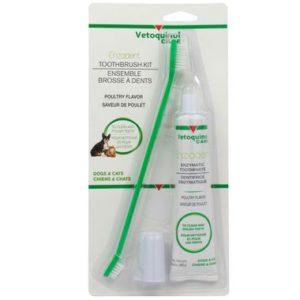 Daily brushing with flavored dog and cat enzymatic toothpaste is the BEST and most efficient way to prevent dental disease. Choose a toothpaste made specifically for your pet and is listed as enzymatic (containing glucose oxidase to reduce bacteria). Never use human toothpaste as it could harm your pet. There are many brands and flavors to choose from (my cat and dog LOVE the poultry flavor) and a wide array of toothbrushes, finger brushes, or simple gauze pads designed with your pet in mind.
Daily brushing with flavored dog and cat enzymatic toothpaste is the BEST and most efficient way to prevent dental disease. Choose a toothpaste made specifically for your pet and is listed as enzymatic (containing glucose oxidase to reduce bacteria). Never use human toothpaste as it could harm your pet. There are many brands and flavors to choose from (my cat and dog LOVE the poultry flavor) and a wide array of toothbrushes, finger brushes, or simple gauze pads designed with your pet in mind. - Dental wipes: There are presoaked dental wipes (even finger pads) for dogs and
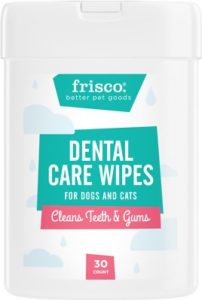 cats. You place the wipe firmly around your finger, lift up the flap of your pet’s mouthand swipe the teeth and gums. Use daily.
cats. You place the wipe firmly around your finger, lift up the flap of your pet’s mouthand swipe the teeth and gums. Use daily. - On a budget? There are pet toothpaste recipes available online that can get you started with a few basic and inexpensive ingredients using baking soda and a simple cloth.
- Tips to succeed with brushing: Begin by gently touching your pet’s face, mouth, gums and teeth on a daily basis (called desensitizing). After your pet is use to this, allow him to lick some of the pet toothpaste off your finger. Some will view this time as a special treat if they love the flavor you choose, like my own dog and cat! Next, begin rubbing your finger/toothpaste over a few teeth (no need to open his mouth at this point – just stick your finger on either side of his mouth for a quick swipe). Once he is used to this, gradually introduce the toothbrush, finger brush, or pads, beginning with a small area and gradually increasing to the whole mouth. Be sure to brush both the teeth and gums. Be patient with this process. Your pet will eventually get use to the routine. Cats may take a little longer than dogs, but it can be done. Always conclude each session with praise, petting, and a special treat, even if it didn’t go so well.
No Brushing Products: There are other methods to remove plaque and tartar without brushing your pet’s teeth. These methods may not give the same effectiveness as -brushing with pet toothpaste- would, but they are still a great start to good oral health.
- Water additives: A non-toxic, tasteless water additive for dogs and cats. Safely
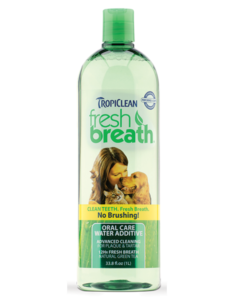 neutralizes bad breath and fights tartar, plaque, and gum disease. Just add to their water bowl daily. Remember to leave out two bowls of water (with and without the additive) in case your pet doesn’t like it.
neutralizes bad breath and fights tartar, plaque, and gum disease. Just add to their water bowl daily. Remember to leave out two bowls of water (with and without the additive) in case your pet doesn’t like it. - Oral care spray/gel: Helps remove plaque and tartar. Apply 2 drops of
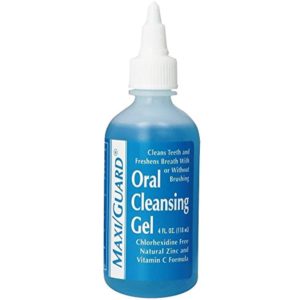 gel (or spray) to each side of your pet’s mouth. Withhold food for 30 minutes before and after treatment for best results. This product can be placed directly on any tartar buildup. Use daily.
gel (or spray) to each side of your pet’s mouth. Withhold food for 30 minutes before and after treatment for best results. This product can be placed directly on any tartar buildup. Use daily. - Chew toys and dental treats:
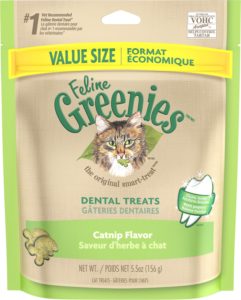 Look online or visit a few pet stores for special pet chews made specifically for dogs or cats that contain enzymes which help dissolve tartar before it hardens into plaque. There are also a broad range of dental cat and dog treats. A popular dental treat readily available in most stores is called “Greenies.” Just find one your pet loves!
Look online or visit a few pet stores for special pet chews made specifically for dogs or cats that contain enzymes which help dissolve tartar before it hardens into plaque. There are also a broad range of dental cat and dog treats. A popular dental treat readily available in most stores is called “Greenies.” Just find one your pet loves! - Veterinarian prescribed pet foods: There are foods designed with your pet’s dental health in mind. Contact your veterinarian to see if this is the right route for you. Never rely on regular kibble or dry food to remove tartar and plaque as these simply do not work. On a side note, cats need some canned wet food in their daily diets in order to maintain a long and healthy life. For more information on the importance of wet food click here, “Cat’s need wet food now for fewer problems later.”
In Summary: Good and consistent dental care, including yearly vet visits and a daily routine, is essential for your pet’s overall health and long life. We know dental care isn’t something that is discussed often enough and you probably had no idea how important it was, but now that you do, we hope you will make this change as your pet will have a happier & longer life.
.

